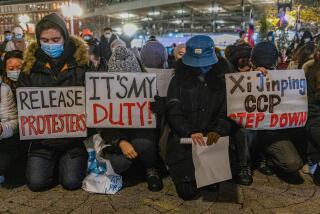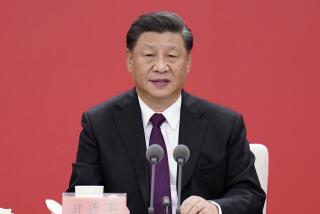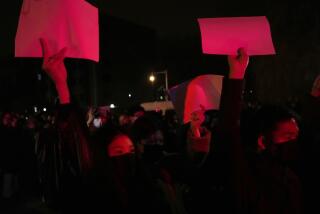Freer Spirit Follows Beijing’s Reforms : Tale of Two Journals: Orthodox and Not
- Share via
BEIJING — During Chairman Mao Tse-tung’s Cultural Revolution, the theoretical journal Red Flag was one of the few publications in China that really mattered, but now it has been eclipsed by a lively newsmagazine.
During the 1960s, a popular saying was that those in the know read “two newspapers and one journal”--a reference to the People’s Daily, the Liberation Army Daily and Red Flag.
Red Flag was so dear to Mao that he chose the name himself, according to Chen Zhanchao, director of the magazine’s general editorial office, and the Chinese characters for the magazine’s masthead “are Mao Tse-tung’s own calligraphy.”
Importance Diminished
Red Flag, founded in 1958, is still the official voice of the Chinese Communist Party, but since the end of the 1966-76 Cultural Revolution its importance has diminished.
“Publications are more numerous now, and thinking is more lively,” Chen said. “There is more competition.”
The most important of the new publications is a weekly journal called Outlook. Since it first appeared in 1984, Outlook has reflected the spirit of reform promoted by Premier Zhao Ziyang, who was confirmed as general secretary of the party early this month.
Red Flag, on the other hand, was until very recently dominated by Zhao’s ideological rivals in the party.
Outlook, a cross between a journal of theory and an American-style news magazine, is published by the state-run New China News Agency. However, according to Li Naiyin, its editor in chief, the articles in it should not be viewed as the official voice of the government.
“Red Flag is an organ of the party Central Committee,” Li said in an interview. “Outlook is not such an organ. Because of this, it can be more exploratory. . . . The Chinese government does not entrust Outlook to issue its views.”
Outlook, which has 48 pages and a circulation of 500,000, is China’s only weekly news magazine, Li said.
“There are so many newspapers, and people don’t have time to read everything,” he said. “We summarize and analyze things. We touch on politics, economics, culture, education, social life and international affairs.”
There is also an international version of Outlook, with different content, published in the old-style characters recognized by most overseas Chinese, he said. This version aims at providing a window into China.
‘Product of Reform’
Outlook itself is “a product of reform,” Li said, “so naturally one of its major topics is to convey information about the reforms.”
“Our publication explores questions because our reform is in an experimental stage,” he explained. “We need such a stage to determine what is correct and what is not correct.”
Two years ago, Li said, Outlook published an article advocating enactment of a bankruptcy law for state enterprises.
“We felt this view had value and was worth being discussed,” he said. “But whether we want to allow bankruptcy or not hasn’t been decided.”
This spirit of relatively free inquiry--albeit within limits set by the basic policies of the party--has drawn readers to the pages of Outlook when they want to know what the market-oriented reformers around Zhao may be thinking up next.
Red Flag, a twice-monthly, 48-page magazine with a circulation of 3 million that goes primarily to party, government, industrial, educational and other work units, is less free-wheeling theoretically and carries little news. Even Red Flag has loosened up a little, but the tradition has been that as the official voice of the party, whatever it prints should be presented as correct, not exploratory.
Also, until about two months ago, Red Flag was dominated by hard-line party officials who were critical of the relatively liberal economic and political reforms being promoted by Zhao and his allies.
Contrasting Approaches
When an orthodox ideological campaign against “bourgeois liberalization” was undertaken early this year, Red Flag took part with enthusiasm, while Outlook sought to define strict limits to the attack on Western ideas of democracy and capitalism.
Red Flag’s previous editor, Xiong Fu, was removed from the post late this summer. Xiong, 72, is viewed as a close associate of China’s two leading orthodox ideologists, Hu Qiaomu and Deng Liqun. In an important victory for reformers at the recently concluded 13th National Congress of the Communist Party, these two once-powerful ideologues lost their places on the Central Committee.
A deputy editor of Red Flag, Su Xing, an economist in his early 60s who is viewed as sympathetic to reforms, was assigned in September to take over Xiong’s duties, although not his title. In its last few editions, the journal has adopted a much more reformist tone.
However, the perception that Zhao is dissatisfied with Red Flag remains widespread, and this has contributed to the circulation of rumors in Beijing that some sort of drastic change is in store for the magazine.
Last month, the Hong Kong magazine Asiaweek, citing an unidentified Chinese source, said “if Zhao has his way, (Red Flag) will become a unit under the central party school and be merged with the school’s Monthly Journal of Theory.”
“Officials made redundant by the move will be sent to the provinces,” the magazine said.
‘Rumors Are Rumors’
Chen, asked about the rumors of impending change, replied that “rumors are rumors,” and added: “The Central Committee’s plans for Red Flag are the Central Committee’s business. As long as the Central Committee has not told us anything, it is very hard to believe hearsay.”
In any case, the latest party congress created new conditions for Red Flag by endorsing a reformist ideology that holds that China is only in “the primary stage of socialism.”
According to the new theory, during this period, which is expected to last at least until the middle of the next century, methods traditionally thought of as capitalistic should be used if they contribute to economic growth. Because this has become party policy, Red Flag is now a clear voice for reform.
More to Read
Sign up for Essential California
The most important California stories and recommendations in your inbox every morning.
You may occasionally receive promotional content from the Los Angeles Times.










